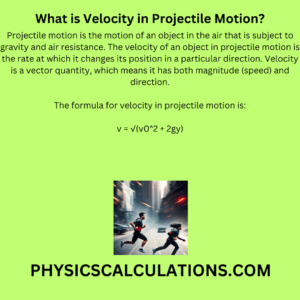What is Velocity in Projectile Motion?
Projectile motion is the motion of an object in the air that is subject to gravity and air resistance. The velocity of an object in projectile motion is the rate at which it changes its position in a particular direction. Velocity is a vector quantity, which means it has both magnitude (speed) and direction.

Formula
The formula for velocity in projectile motion is:
v = √(v02 + 2gy)
Where:
- v is the velocity of the object
- v0 is the initial velocity of the object
- g is the acceleration due to gravity (9.8 m/s2)
- y is the vertical displacement of the object from its starting point
Components
Velocity in projectile motion can be broken down into two components: horizontal velocity and vertical velocity. The horizontal velocity is constant throughout the motion and does not change due to the influence of gravity. The vertical velocity, on the other hand, changes due to the acceleration of gravity. The resultant velocity is the vector sum of the horizontal and vertical velocities.
Importance
It is an important concept in projectile motion. This is because it determines the trajectory of the object. Therefore, the trajectory of the object is the path it follows through the air. It is also determined by both the initial velocity and the angle at which the object is launched.
Examples
Let’s consider an example to help us understand it better. Suppose you throw a ball from the ground at an angle of 45 degrees with an initial velocity of 20 m/s. What is the velocity of the ball at the highest point of its trajectory?
Using the formula for velocity in projectile motion, we can calculate the velocity as follows:
v = √(v02 + 2gy)
v = √(202 + 2(-9.8)(5))
v = √(400 – 98)
v = √302
v ≈ 17.4 m/s
Thus, the velocity of the ball at the highest point of its trajectory is approximately 17.4 m/s.
Frequently Asked Questions
Q1. What is the difference between speed and velocity in projectile motion?
A1. Speed is a scalar quantity that refers to how fast an object is moving, whereas velocity is a vector quantity that refers to the speed of an object in a particular direction.
Q2. What are the components of velocity in projectile motion?
A2. It is broken down into two components. We have horizontal velocity and vertical velocity. The horizontal velocity is constant throughout the motion and does not change due to the influence of gravity. The vertical velocity, on the other hand, changes due to the acceleration of gravity.
Q3. How does the angle of launch affect the velocity in projectile motion?
A3. The angle of launch affects the velocity in projectile motion by determining the vertical and horizontal components of the velocity. The optimal angle of launch for the maximum range is 45 degrees.
Q4. What happens to the velocity of an object in projectile motion when air resistance is considered?
A4. When air resistance is considered, it decreases as it moves through the air due to the opposing force of air resistance.
Conclusion
Velocity in this concept is important because it helps us to determine the trajectory of an object in the air. The formula for calculating it is v = √(v02+ 2gy). The symbol v is the velocity of the object, v0 is the initial velocity of the object, g is the acceleration due to gravity, and y is the vertical displacement of the object from its starting point. Once you understand the topic of this article. You will have a better understanding of the motion of objects in the air and calculate their velocity accurately.
You may also like to read: